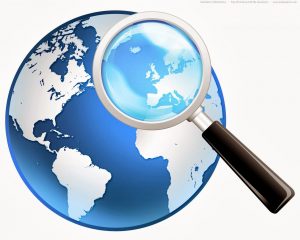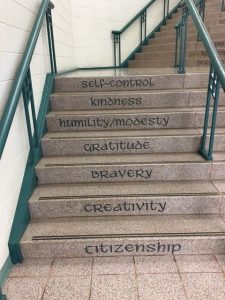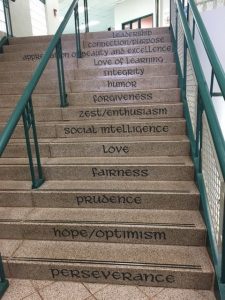I am writing this blog while at the Center for Contemporary Arab Studies at Georgetown University. Today they are offering a fantastic day on Trans Regional and Global Themes in Teaching: African, Latin American, Asian and Middle Eastern Perspectives. Yes, I know what you are thinking “WOW!”
This event is made possible my one of the most amazing networks of teaching and learning – the National Resource Centers. I strongly suggest that you add these groups to your network.
Today is also the culminating event in a journey that began for me in August. In mid-month I left for Budapest the day after my last post and flew back to the USA from Prague about two weeks later. Since that trip and the start of the school year I have had the pleasure of discovering a multitude of resources that can transform your class and students learning.
I am not using the word “transform” loosely by the way. I am convinced that the combined quality , application, and range of items below will cause you to pause and think about both your practice and how you provide your students with experiences in global citizenship education.
The collection of resources come from colleagues, social media, events I have attended, students etc. They touch the five areas you can modify to augment global education: (a) instruction (b) assessment (c) curriculum (d) educational vision and (e) professional learning.

As you explore, here are some guiding questions:
- Where are there gaps in your knowledge?
- How can you teach complexity, not simple binaries?
- What is your understanding of Globalization?
- How can you modify your student experiences to prepare them for tomorrow?
I didn’t know when to stop… so I kept going. I also did not categorize these, but rather provide some descriptions. Also, here are some beginning ideas on how to make them move to a globally centered classroom:
- Use powerful stats and comparative data to inspire student curiosity…
- Metacognition and reflecting on the world shapes students view of existence…
- Use the news as a method to discuss key issues. …
- Use topics and choice so kids can connect more easily…
- Learn about the Millennium Development Goals and Globalization…
- Start with big questions and student inquiry …
- Concepts transcend content and invites student background knowledge…
- Have your students engage with other students around the world…
I hope you enjoy these and would love to hear how you used them. So, leave a comment and make me smile. Happy exploring! But before you start, watch this video from Alan November.
- The World in 2050: Are you teaching for tomorrow? Two resources here can help you make that pivot. 1) The report and PWC website and 2) The BBC Documentary in case one link breaks, here is another.
- Global Ed Conference, Nov 13-16, 2017 – The 8th annual free, online Global Education Conference takes place November 13-16. We are still accepting proposals through November 5th. Please share this information with any potentially interested friends and colleagues! See previous conference archives here.
- Preparing Young Americans for a Complex World: Last year, the Council on Foreign Relations and National Geographic commissioned a survey to assess the global literacy of American college students. Over 1,200 people participated; less than 30 percent earned a passing grade.
- Global Competence and Rubrics: The Asia Society has rubrics and assessments for your class and school to
 use. This is a remarkable and valuable collection of resources. Enjoy!
use. This is a remarkable and valuable collection of resources. Enjoy! - Instructional Strategies for Global Thinking: From Harvard’s Project Zero, these approaches foster understanding and appreciation of today’s complex globalized world. The materials and tools include a framework to think about global competence and offer clarity about various capacities associated with global competence. The bundle describes how to plan and document your experiences bringing global thinking routines into your classroom and to share these experiences with others.
- 100 People: A World Portrait and Global Ed Toolkit: The 100 People Foundation helps students to better understand the complex issues facing our planet and the resources we share. By framing the global population as 100 people, our media makes education more engaging and effective, and improves students’ abilities to remember and relate to what they learn.
- Our World in Data: Our World in Data is an online publication that shows how living conditions are changing. The aim is to give a global overview and to show changes over the very long run, so that we can see where we are coming from and where we are today. The project, produced at the University of Oxford, is made available in its entirety as a public good.
- The World Population Project: The genesis of this project was World Population, a simple, yet powerful, video animation of “dots on a map” representing population changes through time. First produced by Population Connection (Zero Population Growth at that time) over 40 years ago, the video became a popular teaching resource. This spawned new editions that have been viewed in classrooms, museums and boardrooms worldwide. The new 2015 version is viewable here in six languages and contains the latest population projections.
- Global Religious Diversity: The Pew Center’s study from 2014. In order to have data that were comparable across many countries, the study focused on five widely recognized world religions – Buddhism, Christianity, Hinduism, Islam and Judaism – that collectively account for roughly three-quarters of the world’s population.

- US Institute of Peace: List of International Organizations- A list of links to international organizations’ web sites.I am always stunned when students and adults can’t identify 10 of these groups. Please teach about these.
- US Institute of Peace: Glossary of Terms – To help practitioners, scholars, and students answer questions about terminology, USIP developed the Peace Terms: A Glossary of Terms for Conflict Management and Peacebuilding. This extensive glossary provides short definitions of a wide range of complex and often confusing terms used in the field of conflict resolution.
- United States Diplomacy Center’s Diplomacy Simulations Program: The United States Diplomacy Center’s education programs immerse students in the world of American diplomacy and the critical work of the United States Department of State. At the heart of the Center’s education programs are our diplomacy simulations. These are hands-on exercises that allow students and teachers to experience what it is like to be a diplomat while grappling with complex foreign affairs topics.
- US State Department- Discover Diplomacy: Diplomacy is a complex and often challenging practice of fostering relationships around the world in order to resolve issues and advance interests. Discover the PEOPLE who conduct diplomacy, the PLACESwhere the Department of State engages in diplomacy, and the ISSUESdiplomacy helps resolve.
- The White Tourists Burden: Opinion article about voluntourism and the “white savior” complex. Also, African’s Message for America: Article and video about thinking about working locally before going to “save” Africa.
- SAMR Model Resources: The digital revolution in education is full steam ahead, and this challenging process needs solutions on how technology will be used to change education. In 2006, Dr. Ruben Puentedura (P.hd), the President and Founder of Hippasus, a consulting firm based in Western Massachusetts, has come up with the perfect SAMR method to infuse technology into learning and teaching.
- The Right Question Institute: Inquiry is essential for the development of global competence. The skill of question asking is far too rarely deliberately taught in school. We have worked with and learned from educators to develop a teaching strategy that provides a simple, yet powerful way to get students asking their own questions and building off their peers’ questions.
- Environmental Performance Index The 2016 Environmental Performance Index provides a global view of environmental performance and country by country metrics to inform decision-making. Launched at the World Economic Forum, the EPI is in its 15th year and more relevant than ever to achieving the United Nations’ Sustainable Development Goals. A fantastic comparison tool is here!
- Brene Brown Empathy vs. Sympathy Video What is the best way to ease someone’s pain and suffering? In this beautifully animated RSA Short, Dr Brené Brown reminds us that we can only create a genuine empathetic connection if we are brave enough to really get in touch with our own fragilities.
- Brainwaves Video Anthology: The Brainwaves video anthology is produced and filmed by Bob Greenberg. Here you will meet the thinkers, dreamers and innovators; some of the brightest minds in education. This series is meant to inspire and engage the viewer to dig deeper and learn more. A series from global educator Fernando Reimers is here.
- What if western media covered Charlottesville the same way it covers other nations? Fascinating article with a fictional tone similar to Body Ritual of the Nacirema.
- Full RSA Video Library: Want world-changing ideas, world leaders, RSA Animates, self-improvement, talks,
 debates, interviews, animations and loads more?! Well you’ve come to the right place! Be sure to explore the “Insights”, “Animate”, and “Shorts” playlists.
debates, interviews, animations and loads more?! Well you’ve come to the right place! Be sure to explore the “Insights”, “Animate”, and “Shorts” playlists. - Go Global NC – We are Go Global NC and we connect North Carolina to the world and the world to North Carolina. For 35 years our international education and training programs have empowered North Carolina leaders with the skills, understanding, connections, and knowledge to succeed in a global community.
- US History in a Global Context – Free and dynamic resource website that has modules and resources, including how to teach US history this way, for teachers to utilize. Interactive images are library are also included.
- Half the Sky – A four-hour PBS primetime documentary film and national broadcast event inspired by the widely acclaimed book of the same name by Nicholas Kristof and Sheryl WuDunn.
- What the best schools around the world do right -What can other countries learn from these two successful, but diametrically opposed, educational models? Here’s an overview of what South Korea and Finland are doing right. And as an extension, here are images from schools around the globe.
- CNN10 – Explaining global news to a global audience: This is the mission of CNN 10, a new, 10-minute news show that appears as a daily digital video on CNN.com. CNN 10 replaces CNN Student News, the network’s longest-running show that first aired in 1989.
- How does critical thinking happen: Critical thinking skills truly matter in learning. Why? Because they are life skills we use every day of our lives. Everything from our work to our recreational pursuits, and all that’s in between, employs these unique and valuable abilities. Consciously developing them takes thought-provoking discussion and equally thought-provoking questions to get it going.
- California International Studies Project – The California International Studies Project promotes global education through high quality, standards-based, and interdisciplinary professional learning programs for educators in California.
- All Africa – Website that aggregates news produced primarily on the African continent about all areas of African life, politics, issues and culture. It is available in both English and French.
- Global Happiness – Transnational and cultural expressions are important for global education. The 2011 documentary “Happy” and the world happiness report are valuable resources.
- NewseumED : We provide free quality online resources to cultivate the skills to authenticate, analyze and evaluate information from a variety of sources and to provide historical context to current events.
- Reach the World – Reach the World makes the benefits of travel accessible to classrooms, inspiring students to become curious, confident global citizens. Enabled by our digital platform, classrooms and volunteer travelers explore the world together.
- UN SDG Infographic: In September 2015, 193 world leaders committed to 17 Global Goals for sustainable development to end extreme poverty, fight inequality and injustice, and protect our planet by 2030. Education is essential to the success of every one of the 17 new goals.
- List of most sustainable companies in the world: Since 2005, Toronto-based magazine and research firm Corporate Knights has put together the Global 100, an annual list of the world’s most sustainable companies. Using publicly available data, Corporate Knights rates large firms on 14 key measures, evaluating
 their management of resources, finances and employees.
their management of resources, finances and employees. - Facing Today- From the group Facing History and Ourselves, this blog links the past and present with posts by an international community of mindful and creative educators, students, and community members. Great for current events.
- The School of Life: The School of Life is a place that tries to answer the great questions of life. We believe in developing emotional intelligence. We are based online and in 12 physical hubs around the world, including London, Melbourne, Istanbul and Seoul.
- Inequality Index – Inequality isn’t all about income. Here’s a guide to different ranking systems – from wealth distribution to the World Happiness Report – and which countries rate best and worst under each.
- Metrocosm: Metrocosm is Max Galka’s collection of maps and other data visualization projects — trying to make sense of the world through numbers. Some of my favorites: NYC Trash, Global Defense Pacts, World Immigration 2010-2015, Disputed Land Across the Globe.
- Sal Khan Interview on NPR – Tech and a Global Classroom: Sal Khan turned tutoring lessons with his cousins into a series of free educational videos called Khan Academy. His goal: To make learning accessible for everyone, everywhere.
- UN Peacekeeping Missions: An enlightening presentation by scholar Anjali Dayal. This piece by her provides a great framing for the topic. Checkout this video she used to introduce her presentation.

